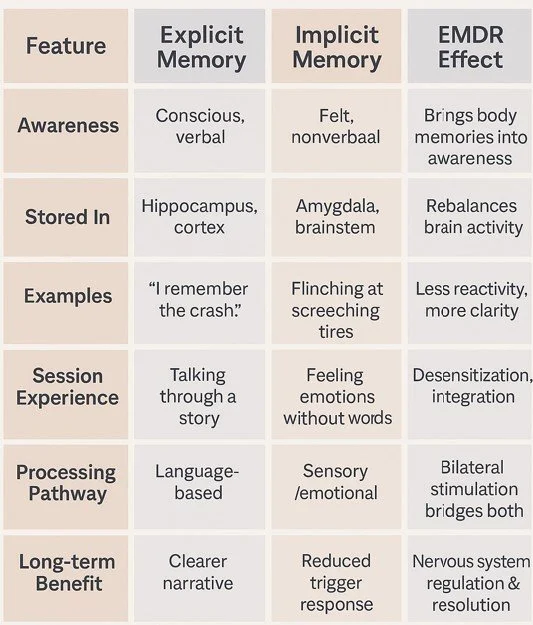Understanding Implicit vs. Explicit Memory—and How EMDR Therapy Supports Trauma Healing
Trauma doesn’t always leave a clear story behind. Sometimes it lingers not in words, but in the body—through tight shoulders, racing thoughts, sudden anxiety, or emotional shut-downs we can’t explain. You might not remember every detail, but something inside does. That’s where understanding the difference between implicit and explicit memory becomes crucial—especially in trauma therapy approaches like EMDR, which work with both the mind and the body to help restore calm and clarity.
What Are Explicit and Implicit Memories?
In her foundational book The Body Remembers, therapist and author Babette Rothschild explains how trauma affects both brain and body. She draws a clear distinction between explicit memories (which we can consciously recall) and implicit memories (which often show up in physical or emotional responses without a clear storyline).
Explicit Memory: The Stories You Can Tell
Explicit memories are the facts and stories we can put into words. They live in parts of the brain like the hippocampus and temporal cortex, where they’re organized into timelines.
Examples:
“I remember the car crash. I was driving on Highway 75 near McKinney.”
“It was Thanksgiving at my aunt’s house in Plano—I remember the smell of the food.”
“I was 12 when we moved to Frisco. I remember the school and the street name.”
These memories might still carry emotional weight, but they’re accessible and can be described clearly.
Implicit Memory: The Reactions You Can’t Explain
Implicit memories are stored outside conscious awareness. They often involve the amygdala, brainstem, and nervous system, and they show up as reactions—without the person knowing why.
Examples:
You tense up or dissociate when someone raises their voice, even though you’re not in danger.
Your heart races when you hear sirens, and you don’t know why.
A certain smell makes you uneasy, even though you can’t tie it to anything specific.
This is the body's way of saying, “Something here feels unsafe,” based on past experiences that weren’t fully processed.
Why Talk Therapy Isn’t Always Enough
Many people begin therapy hoping to “talk through” their trauma—but if that trauma lives primarily in implicit memory, words alone may not be enough. This is where EMDR therapy offers something uniquely effective.
How EMDR Therapy Helps Heal Trauma
EMDR (Eye Movement Desensitization and Reprocessing) is a structured, research-backed therapy developed specifically for trauma. It helps people reprocess distressing memories—whether explicit or implicit—by stimulating both sides of the brain (bilateral stimulation) while focusing on traumatic material.
Why EMDR Is Different
Unlike traditional talk therapy, EMDR engages both the emotional and cognitive brain. It allows people to re-experience traumatic memories in a safe, controlled way, helping the nervous system “file” them properly. This can reduce distress without needing to talk through every detail.
How EMDR Changes the Brain
EMDR isn’t just experiential—it’s deeply rooted in neuroscience. Here’s what the current research shows:
1. Restores Brain Balance
EMDR helps reduce overactivation in the amygdala (the brain’s fear center) and increases activity in the prefrontal cortex, which supports logic, emotion regulation, and self-awareness.
2. Supports Adaptive Memory Storage
After trauma, memories may remain unprocessed—scattered between the body, emotions, and sensory systems. EMDR helps move them into long-term, narrative memory where they can feel more manageable.
3. Reduces Automatic Body Reactions
Studies cited by EMDRIA show that EMDR helps desensitize automatic fight/flight/freeze reactions triggered by implicit memories. Clients often notice they can think more clearly and feel less “hijacked” by their trauma responses.
4. Promotes Lasting Neurobiological Change
EEG and fMRI studies show that EMDR results in long-term changes in neural activity, especially in regions tied to self-regulation and memory integration. Source: EMDRIA. “Neurobiological Correlates of EMDR Therapy Effect in PTSD.” European Journal of Trauma & Dissociation. Additional data: emdria.org
Source: EMDRIA. “Neurobiological Correlates of EMDR Therapy Effect in PTSD.” European Journal of Trauma & Dissociation. Additional data: emdria.org
Chart: Implicit vs. Explicit Memory + EMDR’s Impact
Why This Matters
Unexplained anxiety. A gut-level fear that doesn’t make sense. Emotional shutdowns when discussing something important. These aren’t overreactions—they’re signs that your body is holding onto something your mind hasn’t fully processed.
You don’t need to have a clear memory to begin healing. EMDR helps the brain and body work together to resolve what’s stuck—so your past stops intruding on your present.
Start the Healing Process in McKinney
If you're located in McKinney, Princeton, Frisco, Allen, or anywhere in Texas, I offer in-person and telehealth EMDR therapy for adults navigating trauma, anxiety, or emotional overwhelm.
Curious if EMDR might help? I offer a free 15-minute consultation to discuss your goals and answer questions—no pressure, just support.
About the Author
Elizabeth Boudreau-Boyer, LMFT
I'm a psychotherapist and yoga teacher based in McKinney, TX. My work is grounded in trauma-informed, inclusive care that honors the whole person—mind, body, and nervous system. I specialize in EMDR therapy and draw from a blend of evidence-based and integrative approaches to support adults navigating anxiety, PTSD, grief, and life transitions.
Disclaimer
This blog is for educational purposes only and does not substitute medical advice or psychotherapy. If you’re in crisis, please call 911 or the Suicide & Crisis Lifeline at 988.


